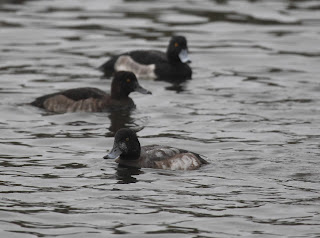 |
| A Spring Lamb |
So to begin with this time, a picture of (I hate to admit it) a rather cute lamb! Eponymous of Spring these little mammals are actually with us for a more scientific reason, although looking cute is a nice bonus! We use lambs and sheep on our reedbed because unlike other grazing livestock, they don't eat reed. As we try to develop our reedbed to eventually provide suitable habitat for Bitterns and Bearded Tits, we need it to be able to grow as freely as possible and with little competition, making these guys perfect!
Another sure sign that Spring is well and truly here is that everything begins to "court" so to speak. All over the reserve there are signs that everything is getting ready to begin mating and raising young. While one of our Barn Owl boxes is housing Barn Owls, the other is providing a nice home to a pair of Kestrel, and this female can regularly be seen sitting on her front porch! While Barn Owl boxes are not always occupied by the intended species, they are now considered essential for sustaining Barn Owl populations, and with Kestrel and Stock Dove (Amber listed in the UK) being the other species that usually take over, they are always beneficial!
 |
| Female Kestrel, Falco tinnunculus |
As I said before, in our other Barn Owl box we have a pair which can often be seen hunting at Freiston early morning an evening. The long grass on the edge of the tracks and hedgerows provide essential hunting grounds for these graceful predators. The Barn Owl is a Schedule 1 species in the UK, making it a criminal offence to disturb or persecute them. Their demise can be attributed to many things, the destruction of natural nest sites (woodland and old buildings), the use of pesticides that enter the food chain through their prey, and also the destruction of suitable long grass meadows for them to hunt over. However, with a lot of hard work, things are looking up for this magnificent creature!
 |
| Barn Owl, Tyto alba |
It's not just birds that are showing the signs either; I found this pair of Common Toad making their way toward a body of water, the male clearly thinking it was too far for him to hop! Toads are incredibly faithful to their breeding grounds and will often return to breed at the pond where they were spawned. What normally happens is that the males gather at the breeding site and remain there for a few weeks, while the females stay for only a short period. However, this male clearly hadn't read the plot and had intercepted this female before she even reached the water! It is said that male toads are rather keen, and have been know to mount inanimate objects and even each other in a breeding frenzy. This makes it a stressful time and mortality is often high. The mounting of the male on the females back in know as Amplexus, and the two toads will remain in this state for a few days as the female makes here way around the pond laying her eggs while the male fertilizes them!
 |
| Male and Female Common Toad, Bufo bufo |
And finally for this post, it is that time of year to dust off the moth traps! We have begun trapping in the garden over the last week, and while catches have been very small (maximum haul 3 so far), we have had one interesting (ecologically it must be said) species for Lincolnshire, in the form of the scarce-for-the-area Pale Pinion. We have also been catching Hebrew Character and Common Quaker so far, which i are more interesting to look at! Moth trapping is very easy, a good moth book is relatively cheap and it is a fantastic way of getting close to nature and practicing ID techniques; however the one question that trumps all others still remains, why exactly are moths attracted to light? More research to come.....but for now, the Pale Pinion in all its glory!
 |
| Pale Pinion, Lithophane hepatica |






















































